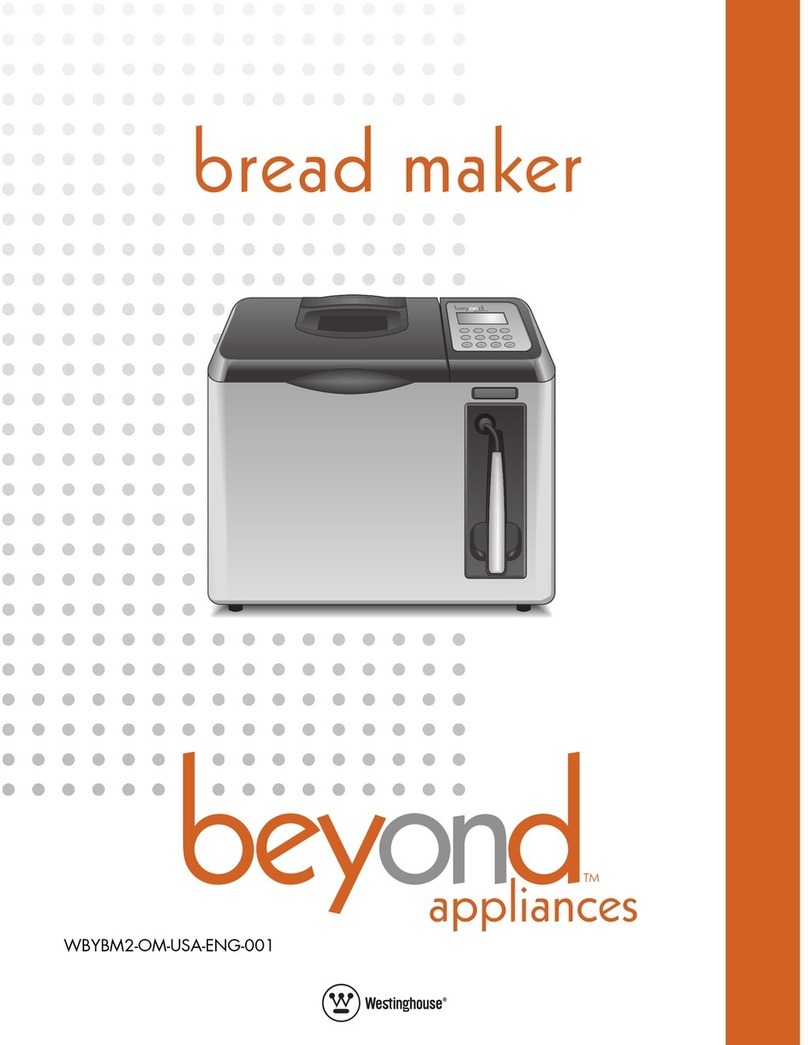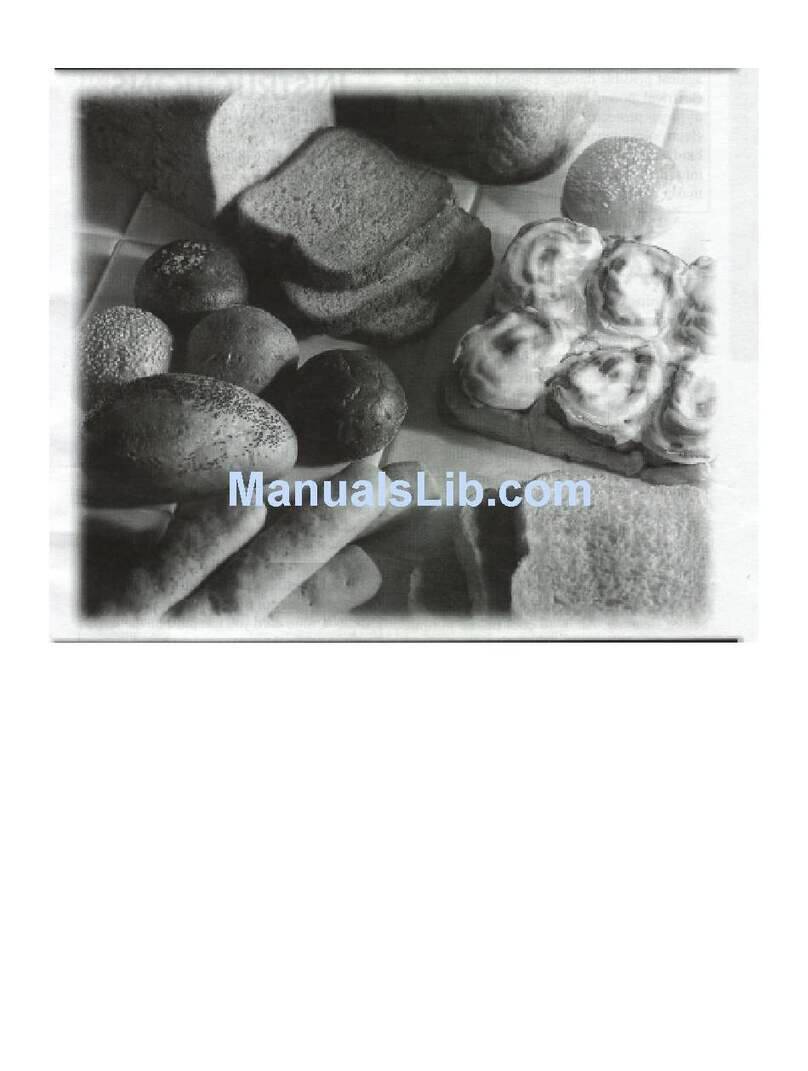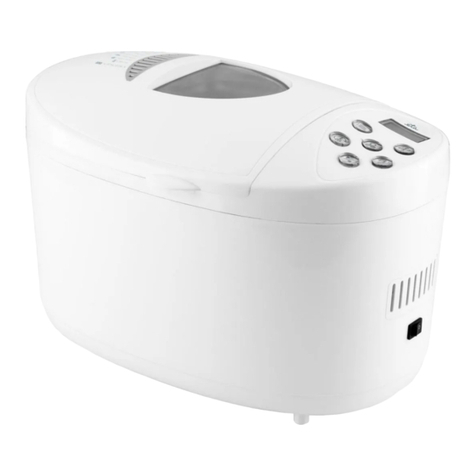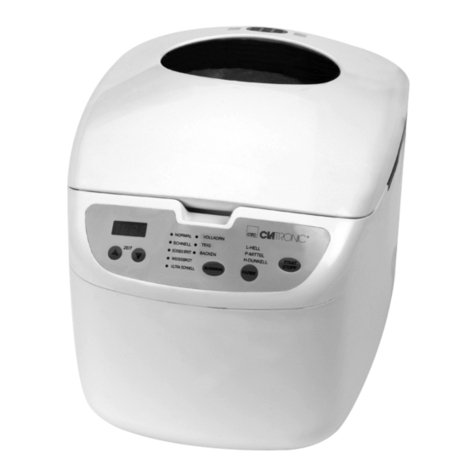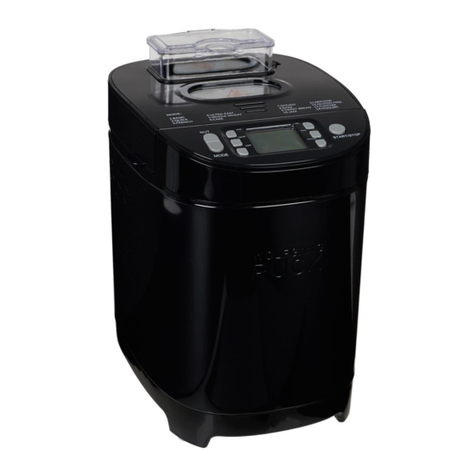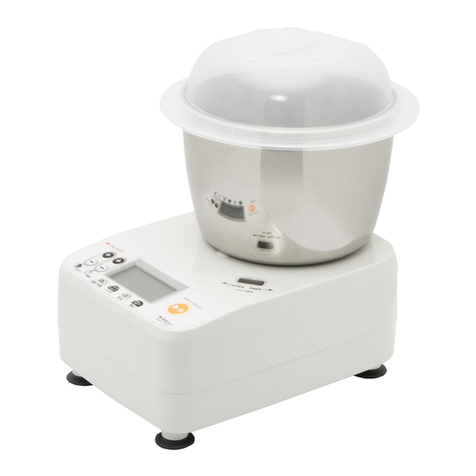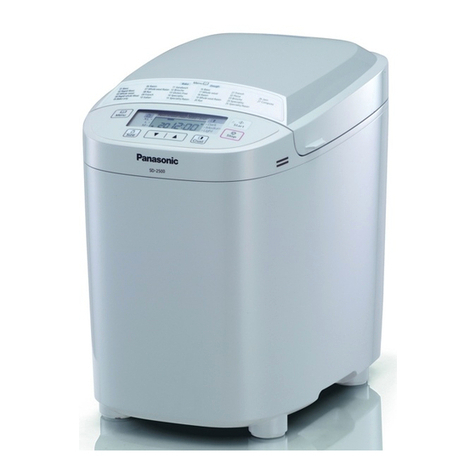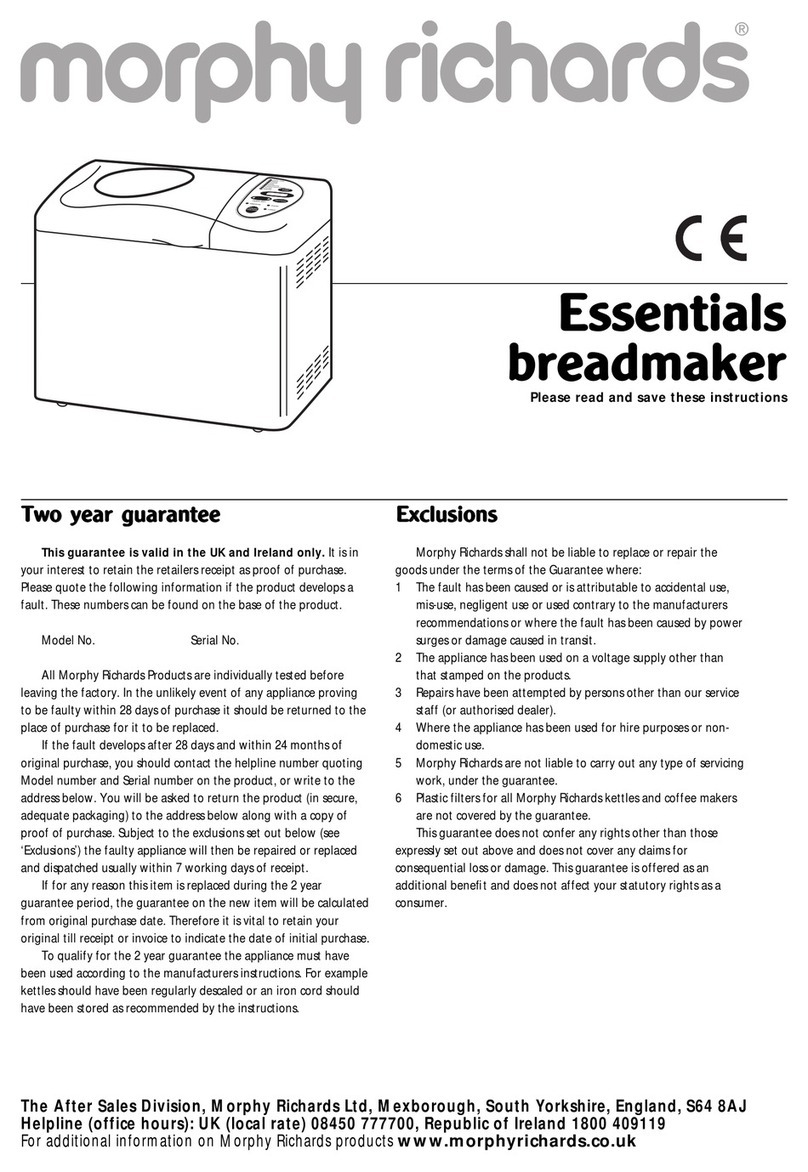DèLonghi BDM1500 User manual

188
INDEX
Using the appliance safely . . . . . . . . . . . . . . . . . . . . . . . . . . . . . . . . . . . . . . . . . . . . . . . . . . . . .189
Characteristics of the appliance and accessories . . . . . . . . . . . . . . . . . . . . . . . . . . . . . . . . . . . . . .190
Control panel . . . . . . . . . . . . . . . . . . . . . . . . . . . . . . . . . . . . . . . . . . . . . . . . . . . . . . . . . . . . . . .192
Baking progress indicator . . . . . . . . . . . . . . . . . . . . . . . . . . . . . . . . . . . . . . . . . . . . . . . . . . . . . .193
Menu settings . . . . . . . . . . . . . . . . . . . . . . . . . . . . . . . . . . . . . . . . . . . . . . . . . . . . . . . . . . . . . . .194
Using the appliance . . . . . . . . . . . . . . . . . . . . . . . . . . . . . . . . . . . . . . . . . . . . . . . . . . . . . . . . . .196
Simple steps to bake with the appliance . . . . . . . . . . . . . . . . . . . . . . . . . . . . . . . . . . . . . . . . . . . .198
Baking bread: an art and a science . . . . . . . . . . . . . . . . . . . . . . . . . . . . . . . . . . . . . . . . . . . . . . .199
Important tips for measuring quantities . . . . . . . . . . . . . . . . . . . . . . . . . . . . . . . . . . . . . . . . . . . . .200
The baking process . . . . . . . . . . . . . . . . . . . . . . . . . . . . . . . . . . . . . . . . . . . . . . . . . . . . . . . . . .200
How to use the Delay Bake function . . . . . . . . . . . . . . . . . . . . . . . . . . . . . . . . . . . . . . . . . . . . . . .201
Power failure backup . . . . . . . . . . . . . . . . . . . . . . . . . . . . . . . . . . . . . . . . . . . . . . . . . . . . . . . . .202
Practical tips . . . . . . . . . . . . . . . . . . . . . . . . . . . . . . . . . . . . . . . . . . . . . . . . . . . . . . . . . . . . . . . .202
Cleaning and maintenance . . . . . . . . . . . . . . . . . . . . . . . . . . . . . . . . . . . . . . . . . . . . . . . . . . . . .203
Recipes . . . . . . . . . . . . . . . . . . . . . . . . . . . . . . . . . . . . . . . . . . . . . . . . . . . . . . . . . . . . . . . . . . . .204
Information on the display . . . . . . . . . . . . . . . . . . . . . . . . . . . . . . . . . . . . . . . . . . . . . . . . . . . . . .215
Troubleshooting . . . . . . . . . . . . . . . . . . . . . . . . . . . . . . . . . . . . . . . . . . . . . . . . . . . . . . . . . . . . .216
FAQ . . . . . . . . . . . . . . . . . . . . . . . . . . . . . . . . . . . . . . . . . . . . . . . . . . . . . . . . . . . . . . . . . . . . . .218
Important information for correct disposal of the product in accordance with EC Directive 2002/96/EC.
At the end of its working life, the product must not be disposed of as urban waste.
It must be taken to a special local authority differentiated waste collection centre or to a dea-
ler providing this service.
Disposing of a household appliance separately avoids possible negative consequences for the
environment and health deriving from inappropriate disposal and enables the constituent mate-
rials to be recovered to obtain significant savings in energy and resources.As a reminder of the
need to dispose of household appliances separately, the product is marked with a crossed-out
wheeled dustbin.
TECHNICAL SPECIFICATION
heating element 800W motor 120W
frequency 50Hz voltage 220V - 240V
net weight 6kg

USING THE APPLIANCE SAFELY
1. Read all instructions, warnings and labels carefully.
Keep these instructions.
2. Remove all "foreign" material from the bread pan.
3. Clean the bread pan and paddle before use.
4. Remove the plastic film from the control panel and all labels.
5. Always plug the appliance into a 220 - 240V AC socket
6. Do not rest anything on the power cable. Do not touch the hot surfaces of the appliance.
Do not lay or leave the power cable across transit points or where someone could trip over it.
Do not rest the appliance on the edge of a table or bench.
During use
1. This appliance is cold to the touch, but heats up during operation. Keep hands and face away.
2. Do not open the lid or remove the bread pan while the appliance is operating unless specifically indica-
ted in the instructions.
3. Do not place anything on the lid of the appliance.
Do not cover the vents. The appliance becomes hot when in operation.
Never rest anything on the top while in use.
Never touch the heating elements inside the appliance.
4. The appliance has a power failure backup programme which retains the cooking cycle in the memory in
the event of power failure.
Prolonged power failure could cause the programme to be cancelled (see page 202 for complete details).
5. Do not touch and/or try to block moving parts (e.g. the paddle while in operation).
6. Do not place your hand in the container while the appliance is in operation
7. If the appliance overheats (prolonged use, use empty, etc), the safety thermostat could turn it off.
After cooling down, it will operate as normal.
8. The lid and other surfaces may become very hot when the appliance is in use.
Where to use the appliance
1. Use on a stable heat resistant surface.
2. Do not use the appliance in direct sunlight or near heat sources such as heaters or ovens.
3. Do not place the bread maker on top of other appliances.
4. Keep the appliance away from children as it becomes hot.
In addition, touching the buttons accidentally during operation may stop the baking process
5. Keep the appliance away from furniture, walls and objects which might be discoloured by the heat. Leave
a gap of at least 20 cm at the sides and 30 cm at the top.
After use
1. Unplug from the mains socket after use and before cleaning.
2. Use oven gloves to remove the bread pan after baking.
3. Allow the appliance to cool down before cleaning or putting it away.
4. Read the instructions before cleaning.
Do not immerse the appliance or the plug in water. It could lead to electric shock or damage to the
appliance.
5. Do not use sharp or cutting metal objects to clean the bread pan.
6. If the appliance is kept permanently plugged into the mains sockets after use, put the pan back in the
chamber.
Safety precautions
1. To avoid electric shock or injury, use the accessories recommended by the manufacturer only.
2. Do not use the appliance outdoors, for commercial purposes or for uses other than those for which it was
designed.
189

190
3. If the power cable is damaged, it must be replaced by the manufacturer, the manufacturer's customer ser-
vices or a qualified electrician in order to eliminate all risk.
If the appliance is dropped or damaged in any way do not use it. Take to the nearest authorised custo-
mer services for checking, repair or mechanical or electrical adjustment.
4. Disconnect the appliance by pulling the plug (not the cable).
5. Extensions: the appliance is supplied with a short power cable to reduce the risk of injury caused by
entanglement or tripping over a long cable.
If you need to use an extension, take the utmost care. It must not hang from the work surface where chil-
dren could pull it or trip over it accidentally.
6. Electricity supply: if the electrical circuit is overloaded, the appliance may not operate correctly.
It should therefore be connected to a separate electrical circuit from other appliances.
7. For safety reasons and to avoid unqualified people from carrying out maintenance, certain appliances
have a tamper-proof seal.
These appliances must be taken to the nearest authorised customer services for adjustment and repairs if
necessary.
8. Do not allow the appliance to be used by persons (including children) with psychological, physical or sen-
sory impairments or with inadequate experience or knowledge, unless closely supervised and instructed
by someone responsible for their safety.
Children must be supervised to ensure they do not play with the appliance.
9. IMPORTANT: Incorrect use (wrong recipe, excessively long baking times) could cause the bread to
overheat and produce smoke or flames. If this occurs, do not open the lid. Unplug from the mains power
supply. Leave the appliance to cool down sufficiently before opening the lid.
10.The appliance complies with the following EU directives:
EMC Directive 2004/108/EC and subsequent amendments.
Materials and accessories coming into contact with food conform to European regulation (EC) no.
1935/2004.
11.The appliance must not be operated by a timer or a separate remote control system.
12.This is a household appliance only. It is not intended for use in: staff kitchen areas in shops, offices and
other working environments; farm houses; by clients in hotels, motels and other residential type environ-
ments; bed and breakfast type environments.
13.This appliance can be used by children aged 8 upwards and by persons with reduced physical, sensory
or mental capabilities or who lack of experience and knowledge if they are supervised or have been given
instructions concerning use of the appliance in a safe way and understand the hazards involved. Children
must not play with the appliance. Cleaning and user maintenance must not be carried out by children
unless they are older than 8 and supervised. Keep the appliance and its cord out of the reach of children
under 8 years of age.
If the appliance is used at maximum capacity, NEVER exceed the following quantities:
Flour: 900g
Yeast: 2.5g (1 teaspoon) for all functions - 4g (1 1/2teaspoon) for the wholemeal function
Water: 600g

CHARACTERISTICS OF THE APPLIANCE AND ACCESSORIES
The appliance is a fully programmable bread maker enabling fresh bread to be cooked easily in just a few
hours.
It has the following additional characteristics:
A range of baking and dough functions
Including CLASSICAL, FRENCH, WHOLEMEAL, SALT FREE BREAD, SWEET BREAD, TURBO, PIZZA DOUGH,
PASTA DOUGH, GLUTEN FREE, JAM, OVEN.
Baking progress indicator
Shows each stage of the bread baking process. See page 193 for further information.
Thirteen hour Delay Bake function
You can wake up in the morning to the smell of hot crusty bread thanks to the 13 hour Delay Bake function.
See page 201 for further information.
Power failure backup
Memorises the programme in the event of power failure or temporary voltage surge.
Once power has been restored, baking will resume from where it was interrupted.
See page 202 for further information.
"Cool touch" casing
Makes the appliance safer during baking, especially in the presence of children.
Viewing window
Enables you to see each stage of the bread baking process.
60 minute keep warm function
Keeps the bread hot for up to an hour after baking.
191
Coperchio amovibile
Pannello di comando
Misurino
Tazza graduata
(TBS= cucchiaio) (tsp= cucchiaino)
Oblò di ispezione Teglia di cottura
antiaderente
Involucro esterno
"cool touch"
Spia di
funzionamento
Removable lid Viewing window Non-stick bread pan
Control panel
"Cool touch" casing
Power
indicator
Graduated cup
Measure
(TBS= tablespoon) (tsp= teaspoon)

Beep for fruit and nuts
Make your bread making more creative.
The appliance emits a beep to tell you when to add fruit and/or nuts.
This avoids them breaking up excessively during kneading.
Removable lid
Can be removed for easy cleaning.
Removable non-stick pan
To remove the bread easily and facilitate cleaning the pan.
24h clock
Displays local time and allows you to programme when you want the bread to be ready using the delay bake
function.
My Bread function
Allows you to save a function and your settings (colour, weight etc.) and recall them with a simple touch.
CONTROL PANEL
The control panel is designed to make the appliance easy to use. The required baking programme is simple
to select and the large display makes it easy to read the selected menu and time left to complete the pro-
gramme.
Display
The display shows the programme selected from (1) to (14), the CRUST COLOUR and the WEIGHT of the
loaf.
The display indicates the number of hours and minutes before the end of the cycle.
Menu button
Press the MENU button to select the automatic baking menus from (1) to (14).
The settings are described on page 194.
When the appliance is turned on, the default menu is CLASSICAL.
Crust colour button
Press the "crust colour" button to select the required crust colour: Light, Medium, Dark.
The default setting is Medium .
192
control panel

193
Weight 750g 1000g 1500g
Press the kg button to select the size of loaf: 750g, 1000g or 1500g.
The default setting is 1000g.
Delay/adjustment
Completion of the chosen programme can be delayed for up to 13 hours by pressing the button.
START/STOP button
Starts the selected recipe or the countdown before the Delay Bake function begins.
To stop operation or cancel the timer setting, hold the button down for a few seconds (the appliance emits
a beep).
BAKING PROGRESS INDICATOR
The baking progress indicator displays all phases of the baking cycle by means of an arrow at the side of
the display (see figure).
TIMER: (available for functions P1-2-3-4-6-11-14 only).
Shows that the Delay Bake function has been set.
PRECOOKING: (available for function 11 only).
The appliance preheats the ingredients before the initial kneading phase begins.
KNEADING:
The bread is in one of the two kneading phases, mixing or punching down.
RESTING
The bread is resting.
LEAVENING:
The bread is in one of the leavening phases, encouraged by the low temperature.
BAKING:
The bread is being baked. This is the final stage of the cycle during which a high temperature is required to
bake the bread.
KEEPING WARM:
This process begins when the bread baking cycle is complete. It keeps the bread warm for up to 60 minutes.
MY BREAD:
The My Bread function is active.

MENU SETTINGS
(1) CLASSICAL
Press the MENU button once,"P1" is displayed. Use this setting to bake traditional white bread.
You can choose three crust colours: Light, Medium or Dark. The appliance is set by default to make a 1000g
loaf with a medium coloured crust.
To select another crust colour, press the "crust colour" button once for darker bread and twice for ligh-
ter bread.
To make a loaf weighing other than 1000g, press the kg button until you reach the required size.
(2) FRENCH
Use to make crustier French or Italian style bread.
Press the MENU button twice,"P2" is displayed.
Use this setting to make bread with a low fat and sugar content.
(3) WHOLEMEAL
Wholemeal bread needs a longer leavening time to compensate for the slower rising of the wholemeal flour.
The baking time for wholemeal bread will therefore be longer and the consistency will be denser.
Press the MENU button three times,"P3" is displayed.
(4) SWEET BREAD
Use to make bread requiring additional ingredients such as sugar, dried fruit, nuts or chocolate to sweeten
it.
Press the MENU button four times,"P4" is displayed.
To avoid the crust being too dark, the Light crust colour is recommended.
(5) CAKE
Makes tasty homemade cakes and pastries.
Can be used to mix and bake cakes. We recommend using ready-to-bake cake mixes. Read the cake making
instructions in the Recipes section. Press the MENU button five times, "P5" is displayed.
(6) GLUTEN FREE
The appliance is programmed with a specific recipe to satisfy the needs of the numerous people allergic to
gluten. As the ingredients for gluten free bread are different, before baking you should read the practical
tips in the Gluten Free instructions in the recipe section.
This setting can also be used to make unleavened bread.
Read the instructions for unleavened bread in the Recipes section.
Press the MENU button six times,"P6" is displayed.
(7) TURBO 1000g
For quicker baking, the TURBO setting speeds up the whole cycle.
A loaf baked using this setting may be smaller and denser given the shorter leavening time.
You are recommended to use the TURBO function to bake CLASSICAL, WHOLEMEAL, SWEET and FRENCH
bread. To use the TURBO setting, place the ingredients in the pan and then place the pan in the appliance.
Press the MENU button seven times, "P7" is displayed.
(8) TURBO 1500g
For quicker baking, the TURBO setting speeds up the whole cycle.
194

195
A loaf baked using this setting may be smaller and denser given the shorter leavening time.
You are recommended to use the TURBO function to bake CLASSICAL, WHOLEMEAL, SWEET and FRENCH
bread.
To use the TURBO setting, place the ingredients in the pan and then place the pan in the appliance. Press the
MENU button eight times, “P8” is displayed.
(9) PIZZA DOUGH
This setting can be used to create a variety of doughs for croissants, bread rolls and pizzas for baking in a
traditional oven.
Read the instructions for Dough in the Recipes section.
Press the MENU button nine times, "P9" is displayed.
(10) PASTA DOUGH
Use this setting to make dough for fresh pasta. When the dough is ready, place the pasta in a machine to
make fettuccine, ravioli and lasagne. Read the instructions for Pasta in the Recipes section.
Press the MENU button ten times,“P10” is displayed.
(11) MILK BREAD
This cycle makes soft bread, slightly sweeter than CLASSICAL bread.
Press the MENU button eleven times, "P11" is displayed.
(12) JAM
Use this setting to make sweet, tasty, fresh jam. Read the instructions for jam in the Recipes section.
Press the MENU button twelve times,“P12” is displayed.
(13) OVEN
When OVEN is selected, the appliance cooks like a normal electric oven.
This setting remains in operation for one hour and can be controlled manually by pressing the START/STOP
button to stop the function at any moment.
Use this setting to complete bread baking if there has been a power failure.
In this case, leave the dough to rise in the pan with the appliance unplugged until it occupies 3/4of the pan.
Plug in to the power socket again, select (13) OVEN, then press START/STOP.
This setting can also be used to increase baking times.
If the bread still looks doughy at the end of the baking cycle or you want to bake it more, just select the OVEN
function and continue baking.
Press the MENU button thirteen times,"P13" is displayed.
(14) SALT FREE BREAD
This bread can be used in thousands of ways - it is an excellent alternative to sliced bread; lightly toasted it
is delicious spread with a little oil, salt and fresh tomatoes; fried it can be used as a base for soups, vegeta-
ble purées and scrambled eggs.
It brings out the best in all dishes as it helps avoid salt without compromising on the flavour, appeal and sati-
sfaction of good homemade bread.
Press the MENU button 14 times, "P14" is displayed.

196
Press the button for at least 2
seconds.
(The hour flashes).
Set the hour by pressing the but-
ton repeatedly.
Press the START/STOP button.
(The minutes flash).
USING THE APPLIANCE
Before using the appliance
You are recommended to remove the pan (see instructions below), clean the pan and paddles with a damp
cloth, then dry thoroughly.
Do not immerse the pan in water unless strictly necessary.
Do not use abrasive cleaning products as they could damage the non-stick surface.
Do not wash accessories in a dishwasher.
Removing the pan
Open the lid of the appliance and remove the pan by holding it by the handle and lifting.
It is advisable to remove the pan before adding the ingredients to avoid them coming in contact with the hea-
ting element.
Adding the ingredients
You should add the ingredients to the pan in the specified order.
All ingredients must be at room temperature and measured carefully.
Replacing the pan in the chamber
To reposition the pan in the appliance, just place it in the chamber and push downwards until correctly posi-
tioned. Leave the handle down towards the side of the pan. Close the lid and plug the appliance into a 220
- 240V AC socket. Please note: when the appliance is plugged in for the first time, it emits a beep and "-- :
--" is displayed.
SETTING THE CLOCK
The first time the appliance is connected to the household electricity supply or after it has been without power
for some time, four dashes ("-- : --") will appear on the display.
To set the time, proceed as follows:

197
Set the minutes by pressing the
button repeatedly.
Press the START/STOP button.
(The set time is displayed).
• If you want to change the time set subsequently, repeat the setting procedure described above.
• After starting the function set by pressing the button, the time when baking will end is displayed.
• To set longer times, hold the button down.
• To cancel the time set, hold the START/STOP button down for at least two seconds.
QUICK HEAT
Simpler than the oven function to complete baking the bread.
In stand-by, press the START/STOP button once. "0.00" is displayed.
Set the baking time with the button (maximum 1 hr).
To start baking, press the START/STOP button again.
To cancel the function, press the START/STOP button for at least two seconds.
CHILD SAFETY
The appliance is fitted with a safety device to prevent children from turning it on unintentionally.
To enable the safety device:
• Press and hold the START/STOP button for 3 seconds.
• The appliance emits a short beep and the symbol is displayed. The oven cannot be turned on.
• To disable the safety device, hold the START/STOP button down for 3 seconds.
MY BREAD FUNCTION
PAllows you to save your favourite baking settings (programme, colour, weight, time when ready, etc.) and
call them up by pressing a single button.
To set the MY BREAD function:
After programming any function (phases 1-6, page 198), press the MY BREAD button for at least two
seconds.
The appliance emits a beep and saves the programme with all your settings.
To recall the MY BREAD function:
In stand-by, press the MY BREAD button. The total baking time is displayed (if local time has been
set, the time at which baking will end) and is displayed.
Press the START/STOP button to start the function.

198
SIMPLE STEPS TO BAKE WITH THE APPLIANCE
The following instructions are designed to help beginners with every phase of the baking process.
These instructions apply specifically to recipes for bread, dough and pasta (see the Recipes section of these
instructions).
You should weigh all ingredients accurately and use the graduated cup and measure provided.
Phase 1 Add the ingredients
Simply add the ingredients to the pan in the following order:
1. Liquid ingredients
2. Dry ingredients
3. Yeast
For good results, it is important to weigh the ingredients accurately and add them in the correct order.
Phase 2 Select the menu setting
Press the MENU button to make the required selection.
Pressing the MENU button scrolls through the recipes from (1) to (14). The number of the recipe is displayed.
Phase 3 Select crust colour
Press the "crust colour" button to select the required crust colour.
You can choose between Light, Medium or Dark.
If you do not choose a specific crust colour, the appliance will automatically adopt the default of Medium.
Phase 4 Select the weight of the loaf
Press the kg button to select the weight of the loaf: 750g, 1000g or 1500g
If you do not choose a specific weight, the appliance will automatically adopt the default of 1000g.
Phase 5 Press START/STOP
Please note: If no selections are made, the appliance will use Menu 1 with a default setting of 1000g and a
medium crust colour.
Press the START/STOP button to confirm the setting.
The hours and minutes left before the end of the cycle are displayed.
If local time has been set, the time at which baking will end will be displayed.
To start the process immediately, press the START/STOP button (the red light comes on).
Phase 6 Hot, fresh, crusty bread
At the end of the baking cycle, the appliance emits a beep and "end" is displayed.
The appliance automatically switches to the "Keep Warm" cycle for 60 minutes.
Hot air circulates through the baking chamber, helping reduce condensation.
Use oven gloves to lift the pan and remove it from the chamber.
Leave the bread to cool in the pan for 10 minutes before removing it. Turn the pan upside down and shake
until the bread comes out.
If necessary use a plastic spatula to detach the bread from the sides of the pan.
Place the bread to cool on a wire rack.
For optimum consistency and easy slicing, you should leave the bread to cool for 15 minutes.

199
After using the appliance
Unplug the appliance and leave to cool for 30 minutes before starting another programme.
If the appliance is reused too soon, it may emit a beep and "HOT" is displayed, indicating that it is not cool
enough. Wait for the appliance to cool down then press START/STOP.
BAKING BREAD: AN ART AND A SCIENCE
Baking bread is both an art and a science.
The appliance does most of the work, but there are some things you need to know about each of the basic
ingredients and the bread baking process.
The ingredients of classical bread are the simplest: flour, sugar, salt, liquid (water or milk), possibly a fat (but-
ter or oil) and yeast.
Each of these ingredients has a particular function and gives a particular taste to the end product.
It is therefore important to use the right ingredients in exactly the right proportions to guarantee the best
results.
Yeast
Yeast is a genuine "active" micro-organism. Put simply, bread will not rise without yeast.
Once moistened with the liquid, fed by the sugar and warmed to the right level, yeast produces the gases
which cause the dough to rise.
If the temperature is too low, the yeast is inactive. If it is too hot, it dies.
The appliance takes this into consideration and maintains the correct temperature in the baking chamber at
all times. You should therefore use active dry yeast only, verifying the "Use by" date of the product because
after this, the yeast will not leaven the bread.
You should make a small hollow in the top of the dry mixture for the yeast. This will make sure it is active
when it comes in contact with the liquid and sugar during kneading.
If you want to use cubes of fresh yeast, use a fork to mash it into the water in the pan.
Flour
You must use a good quality flour before the "Use by" date.
In order for the bread to rise, the flour must have quite a high protein content.
You should therefore use flour suitable for bread making.
Unlike white flour, wholemeal flour contains bran or wheat germ which are heavy and impede leavening.
Wholemeal bread therefore tends to be denser and smaller.
You can obtain a larger lighter loaf by using a mixture of wholemeal flour and white flour in wholemeal bread
recipes.
It is important to weigh the flour required for each recipe to take account of the air naturally incorporated in
the flour. This guarantees perfectly baked bread.
You can uses packs containing large quantities of flour, but the result may vary.
The consistency and height of the loaf will be variable if the flour is kept for long periods in inappropriate
conditions.
Only buy packs of large quantities of flour if you are baking regularly.
Sugar
Sugar sweetens the bread, makes the crust darker and gives it a softer consistency by feeding the yeast.
You can use equivalent quantities of white or brown sugar, treacle, maple syrup, honey or other sweetener.
You can also use equivalent quantities of artificial sweeteners, but the taste and consistency of the bread will
be different.
Liquids
When the liquids are mixed with the flour protein, they form gluten, necessary to leaven the bread.
The majority of recipes use water, but other liquids can be used such as milk or fruit juices.
You should therefore experiment with the amount of these liquids needed to obtain optimum results as a reci-

200
pe containing excessive liquid may cause the bread to collapse during baking, while too little liquid prevents
it from rising. Use liquids at room temperature.
Salt
Used in small quantities, salt makes the bread tasty and controls the action of the yeast.
In excessive quantities, it prevents the bread from rising, so make sure you use the right amount.
You can use any table salt.
Eggs
Eggs are used in some bread recipes. They add liquid, stimulate leavening and improve the nutritional qua-
lities and taste of the bread. They are therefore contained in the sweeter recipes.
Fats
Many types of bread use fats for a stronger taste and to retain moisture.
You can use oil or softened butter in equivalent quantities.
If you do not add fat, the taste and consistency of the bread may be different.
Tips
• Different brands of yeast used with different brands of flour will affect the size and consistency of the
bread.
Try the ingredients to establish the combination which gives the best results.
• It is normal for the height and consistency of the bread to vary even if the same ingredients are used a
number of times.
This variability is usually influenced by natural variations in the wheat protein in the flour.
IMPORTANT TIPS FOR MEASURING QUANTITIES
Each ingredient in the bread has a specific function. It is therefore extremely important to measure the
amounts correctly to obtain the best results.
Please note: for optimum results, you should weigh the ingredients on kitchen scales. This is particularly
important for the flour which incorporates air and is required in precise quantities for perfect bread.
Each recipe indicates the quantities.
If you do not have kitchen scales, use the graduated cup (one cup = 200g of flour) and measure provided,
respecting the following instructions.
Dry ingredients
Use the graduated cup or measure provided.
Do not use tablespoons or coffee cups. Level the cup or measure.
Pour the flour into the graduated cup without pressing down then level with a flat blade.
Do not push dry ingredients down in the cup.
Liquids
Fill the graduated cup to the level indicated.
Check the quantity in the cup by placing it on a flat surface.
And finally...
Put the liquids into the pan first, followed by the dry ingredients and lastly the yeast.
This guarantees good leavening and even baking of the bread.
THE BAKING PROCESS
Mixing, kneading, leavening and baking... this is the succession of phases performed by the appliance.

Mixing and kneading
In traditional baking, the baker first mixes, then kneads manually.
The appliance performs these operations automatically.
Leavening
When baking by hand, after mixing, the dough is placed in a warm place for the yeast to ferment and pro-
duce the gas required for the bread to rise.
After mixing the dough, the appliance maintains the optimum temperature for leavening during this phase of
the process. If a dough only cycle has been chosen, the appliance stops at the end of the first leavening phase.
The dough can now be removed and worked to make flatbread, pizza or other creations, before placing it
in the oven for baking.
Punching down
After leavening, the baker usually "punches down" the dough.
This eliminates large undesirable air and gas bubbles performed during leavening and gives the bread a
more even appetising consistency. The appliance manages this operation automatically by rotating the padd-
le the exact number of times required.
Second/third leavening
After punching down, the bread is leavened a second or third time for a variable period according to type.
For example, wholemeal bread requires a longer leavening time because the flour contains bran and wheat
germ which hinder the process. The appliance automatically regulates the temperature and time of this
second leavening phase according to the settings.
Baking
The appliance automatically adjusts baking time for a perfect result every time!
Cooling
In normal baking, the baker removes the bread immediately from the pan to prevent the crust from becoming
heavy. To achieve the same results, the appliance has a "KEEP WARM" function which encourages elimina-
tion of the hot air from the baking chamber once the bread is baked.
After removing the bread from the pan, leave it to cool for 15 minutes before slicing.
HOW TO USE THE DELAY BAKE FUNCTION
You can delay baking for up to 13 hours, enabling you to wake up in the morning to the fragrance of fre-
shly baked bread, or go out leaving the appliance in operation.
It is important to make a small hollow in the top of the dry mixture for the yeast. This will make sure it beco-
mes active when it comes in contact with the liquid and sugar during kneading.
Please note: do not use the Delay Bake function if the recipe contains perishable ingredients such as milk,
eggs or cheese as they could deteriorate.
Do not use the Delay Bake function for recipes requiring fruit or nuts to be added at a later stage to prevent
them being broken up excessively during kneading.
1. Follow phases 1, 2, 3, 4 and 5 on page 198, confirming the settings with the START/STOP button.
2. Press the button until you reach the number of hours or minutes between the present time and the
time you want the bread to be ready.
If local time has been set, the time at which baking will end will be displayed.
Press the button to set when you want the bread to be ready.
3. Press the START/STOP button and is displayed. (If local time has been set, this will be displayed
instead of "- - : - -").
When the time for the process to begin is reached, a countdown of the time left is displayed.
The bread will be baked and ready at the end of the number of hours and minutes displayed.
If the button is pressed during the process, the time the bread will be ready will be displayed for 2
201

seconds.
Please note: in the event of error or to reset the time, press the START/STOP button.
Example
Before leaving to go to work at 8.00, you might want to set the Delay Bake function in order for the chosen
programme to be finished or the bread to be ready when you get home at 18.00, 10 hours later.
Follow the above instructions, then press the button until 10.00 is displayed. Then press START/STOP.
This means that the bread or selected programme will be completed in 10 hours time.
The appliance begins the countdown and the selected programme will end at 18.00.
If local time has been set, follow the above instructions, then press the TIME button until “18.00” is displayed,
then press START/STOP.
The bread or selected programme will be completed at the required time.
POWER FAILURE BACKUP
The appliance has a power failure backup which retains the cycle in the memory in the event of power fai-
lure or voltage surge.
This means that if there is a power failure while the bread is baking, the appliance will retain the memory
for at least 10 minutes and will continue the baking process when the electricity comes back on.
This option is available during the Kneading, Baking, Leavening or Delay Bake cycles.
Without this feature, the appliance would reset and the bread baking cycle would stop.
If the power failure lasts more than 10 minutes, you may have to throw away the ingredients and start again.
PRACTICAL TIPS
Order of ingredients
Add the liquid first, then the dry ingredients and finally the yeast.
Fruit and nuts should be added later when the appliance has completed the first kneading phase.
This enables evenly cooked crusty bread to be obtained at any moment.
Freshness
Make sure all ingredients are fresh and use them before the specified "Use by" date.
Unlike supermarket bread, bread baked in the appliance does not contain preservatives and therefore will
not keep for as long. Do not use perishable ingredients such as milk, eggs or cheese with the Delay Bake
function. Keep dry products in sealed pans to avoid them deteriorating.
Slicing the bread
For best results, leave the bread to cool for at least 10 minutes before slicing. Place the loaf sideways on and
cut with a bread knife using a sawing movement. Use of an electric bread knife facilitates and standardises
this operation.
Freezing the bread
Before freezing fresh bread, leave it to cool down completely and wrap in plastic.
Slice the bread before freezing and use as needed.
Removing the bread from the pan
Just as with a cake, the bread should be allowed to cool slightly before removing it from the pan.
Leave the bread in the pan for about 10 minutes before removing. To remove the hot pan, use pan handles.
Toppings
During baking, you can add ingredients such as herbs, sesame seeds and pieces of bacon on top of the
bread.
202

Open the lid, brush the bread with a little milk or egg white, then add the topping.
Make sure the ingredients remain inside the pan.
Close the lid and continue baking.
Please note: you should do this as rapidly as possible to make sure the bread does not collapse.
Crust color
It is normal for the top of the bread to be lighter than the sides.
Different combinations of ingredients may make the crust more or less brown.
Baking at high altitudes
At an altitude of more than 900 metres, the dough will leaven more rapidly.
When baking at high altitudes, you should therefore perform a number of tests.
Follow the instructions below and note the one which gives you the most satisfactory results:
1. Reduce the quantity of yeast by 25% to avoid excessive leavening.
2. Increase the salt by 25%. The bread will rise more slowly and will be less likely to collapse.
3. Check the dough during mixing. Flour kept at high altitudes tends to be dryer.
You can add a few tablespoons of water to the dough until an even ball is formed.
CLEANING AND MAINTENANCE
IMPORTANT: Before cleaning the appliance, unplug from the mains socket and leave to cool completely.
Cleaning the outside
Clean the outside of the appliance with a damp cloth and polish with a soft dry cloth.
Do not use metal or abrasive pads. They could scratch the outside surface.
Cleaning the non-stick pan
Clean the pan and paddle with a damp cloth and dry thoroughly.
Do not use abrasives or aggressive household cleaning products as they could damage the non-stick surfa-
ce.
Do not immerse the pan in water.
However, if necessary, it can be washed gently with water and washing up liquid using a soft cloth.
Please note: to clean the pan more efficiently, remove the inside paddle.
Care of the non-stick pan
Do not use metal implements to remove the ingredients or the bread as they could damage the non-stick sur-
face.
Do not worry if the non-stick surface becomes worn or discoloured over time.
This is caused by the action of steam, moisture, food, acids and the mixture of various ingredients, together
with wear and breakage.
It does not represent a risk and does not compromise operation of the appliance.
Do not wash accessories in a dishwasher.
Do not immerse the appliance in water.
Removing and cleaning the lid
To remove the lid, lift to an angle of about 45° and pull towards you.
Clean the inside and outside of the lid with a damp cloth and dry thoroughly before replacing.
Storing
Make sure the appliance is completely cold and dry before storing with the lid closed. Do not place heavy
objects on the lid.
203

204
RECIPES
Important:
The moisture content of the ingredients affects the recipes which may therefore need to be modified. For
example, the weight of the flour changes when it absorbs moisture from the air.
Our recipes can therefore be modified slightly in order to improve the results.
Always note the quantities you use in order to modify the recipes as you wish.
Bread baked in this appliance may have a variable flavour, consistency and appearance.
This is quite normal and generally due to the ingredients used.
To avoid disappointment, read the list of recommended ingredients on page 200 before preparing the reci-
pes in these Instructions.
(1) CLASSICAL
Classical bread method
1. Pour all the liquids into the pan and cover with the flour.
All the other ingredients should be placed separately at the corners and the yeast should be placed in a
small hollow in the centre of the flour.
2. Place the pan in the appliance and close the lid.
3. Press the MENU button until you reach programme (1) CLASSICAL.
4. Select the CRUST COLOUR and WEIGHT of the bread then press the START/STOP button.
Traditional white bread 750g 1000g 1500g
Water 315ml 415ml 600ml
Oil 1 tablespoon 2 tablespoons 3 tablespoons
Flour 600g 680g 900g
Salt 1 1/2teaspoons 2 teaspoons 3 teaspoons
Sugar 1 tablespoon 1 tablespoon 1 1/2tablespoons
Dry yeast 1 teaspoon 1 teaspoon 1 teaspoon
Pumpkin bread 750g 1000g 1500g
Water 300ml 350ml 450ml
Oil 1 tablespoon 2 tablespoons 3 tablespoons
Flour 520g 600g 900g
Chopped/cooked pumpkin 100g 125g 150g
Grated nutmeg 2 teaspoons 2 teaspoons 3 teaspoons
Salt 1 teaspoon 1 1/2teaspoons 3 teaspoons
Sugar 1 tablespoon 1 tablespoon 2 tablespoons
Active dry yeast 1 teaspoon 1 teaspoon 1 teaspoon

205
(2) FRENCH
Method
1. Pour all the liquids into the pan and cover with the flour. All the other ingredients should be placed sepa-
rately at the corners and the yeast should be placed in a small hollow in the centre of the flour.
2. Place the pan in the appliance and close the lid.
3. Press the MENU button until you reach programme (2) FRENCH.
4. Select the CRUST COLOUR and WEIGHT of the bread then press the START/STOP button.
French bread
Water
Oil
Flour
Salt
Sugar
Active dry yeast
750g
290ml
1 1/2tablespoons
520g
1 teaspoon
1 tablespoon
1 teaspoon
1000g
350ml
2 tablespoons
680g
2 teaspoons
1 tablespoon
1 teaspoon
1500g
600ml
3 tablespoons
900g
3 teaspoons
1 1/2teaspoons
1 teaspoon
Sweet and sour bread
Water
Oil
Flour
Yoghurt
Lemon juice
Salt
Sugar
Active dry yeast
750g
220ml
2 teaspoons
540g
75g
2 teaspoons
1 teaspoon
1 tablespoon
1 teaspoon
1000g
270ml
1 tablespoon
700g
100g
1 tablespoon
1 1/2teaspoons
2 tablespoons
1 teaspoon
1500g
450ml
1 1/2tablespoons
810g
125g
1 tablespoon
2 teaspoons
2 tablespoons
1 teaspoon
(3) WHOLEMEAL
Wholemeal bread method
1. Pour all the liquids into the pan and cover with the flour.
All the other ingredients should be placed separately at the corners and the yeast should be placed in a
small hollow in the centre of the flour.
2. Place the pan in the appliance and close the lid.
3. Press the MENU button until you reach programme (3) WHOLEMEAL.
4. Select the CRUST COLOUR and WEIGHT of the bread then press the START/STOP button.
It is quite normal for dough made with wholemeal flour to be very dense.
Check the appliance during the first few minutes of operation. If the dough is not well mixed, use a soft spa-
tula (not metal) to mix the ingredients.
Wholemeal bread 750g 1000g 1500g
Water 320ml 420ml 520ml
Oil 1 1/2tablespoons 2 tablespoons 2 1/2tablespoons
Wholemeal flour 540g 700g 860g
Salt 1 1/2 teaspoons 2 teaspoons 2 1/2 teaspoons
Brown sugar 1 1/2tablespoons 2 tablespoons 2 1/2tablespoons
Active dry yeast 1 teaspoon 1 teaspoon 1 teaspoon

206
Chocolate bread
Water
Oil
Flour
Cocoa
Sugar
Salt
Active dry yeast
When you hear the beep, add:
Pieces of chocolate
750g
250ml
2 tablespoons
400g
1 tablespoon
2 tablespoons
1 1/2teaspoons
1 teaspoon
1/2cup
1000g
375ml
2 tablespoons
500g
1 1/2 tablespoons
3 tablespoons
1 1/2teaspoons
1 teaspoon
3/4cup
1500g
425ml
3 tablespoons
600g
2 tablespoons
2 tablespoons
2 1/2teaspoons
1 teaspoon
1 cup
(4) SWEET BREAD
For optimum results, always select the Light crust colour to avoid the crust burning.
Method
1. Pour all the liquids into the pan and cover with the flour. All the other ingredients should be placed sepa-
rately at the corners and the yeast should be placed in a small hollow in the centre of the flour.
2. Place the pan in the appliance and close the lid.
3. Press the MENU button until you reach programme (4) SWEET BREAD.
4. Select the CRUST COLOUR and WEIGHT of the bread then press the START/STOP button.
Do not use the Delay Bake function with the SWEET BREAD programme as the ingredients are perishable.
Raisin bread
Water
Ground cinnamon (optional)
Oil
Flour
Brown sugar
Salt
Active dry yeast
When you hear the beep, add:
Raisins and sultanas
750g
250ml
1 tablespoon
1 tablespoon
400g
2 tablespoons
1 1/2teaspoons
1 teaspoon
1/2cup
1000g
375ml
2 tablespoons
2 tablespoons
500g
3 tablespoons
2 teaspoons
1 teaspoon
3/4cup
1500g
425ml
3 tablespoons
2 1/2tablespoons
600g
2 tablespoons
2 1/2teaspoons
1 teaspoon
3/4cup
(5) CAKE
Method
1. Place all the ingredients in the pan in the order described. Remove any flour left on the outside of the
pan.
2. Place the pan in the appliance and close the lid.
3. Press the MENU button until you reach programme (5) CAKE.
4. Press the START/STOP button.
5. Mix for 5-8 minutes, open the lid and scrape the sides of the pan with a plastic spatula.
Fold the mixture delicately to blend the ingredients thoroughly.
Close the lid and continue the cycle.
Please note: check the cake when you hear the five second beep and add the required cooking time.
Practical tips for best results
• It is normal for cakes to rise for only a half above the pan. The consistency must be pleasing and light.
• Do not use double quantities of cake mix. A larger denser cake will not cook completely in the applian-
ce.

207
• We recommend using ready-to-bake cake mixes available in all supermarkets.
• Leave the cake to cool in the pan for about 10 minutes before placing it on a wire rack to cool.
• Loosen the sides with a plastic spatula and remove delicately.
Do not use the Delay Bake function when cooking cakes as the ingredients are perishable.
Ricotta cheesecake
180g eggs
180g melted butter
70g milk
275g "00" Italian Flour
100g potato flour
200g sugar
40g ricotta
1 sachet baking powder
Plum cake
180g eggs
100g melted butter
200g Manitoba flour
100g potato flour
150g sugar
160g raisins
1 sachet baking powder
Carrot cake
180g eggs
180g melted butter
70g milk
200g "00" Italian Flour
100g potato flour
190g sugar
70g almond flour
170g chopped carrots
1 sachet baking powder
(6) GLUTEN FREE
Baking good quality gluten free bread takes practice and a better understanding of the various ingredients.
To help you bake perfect gluten free bread, below are a number of practical tips and some information on
the ingredients to read before starting.
Practical tips
• For best results, read the instructions for each recipe carefully.
• All gluten free recipes can be kept well frozen.
• To ensure the ingredients are well mixed, you may need to intervene during the kneading cycle. When
baking the first loaves of bread, check the consistency of the dough for five minutes.
If the dry ingredients are not mixed, use a plastic spatula to scrape the sides of the pan and mix in the
Table of contents
Popular Bread Maker manuals by other brands
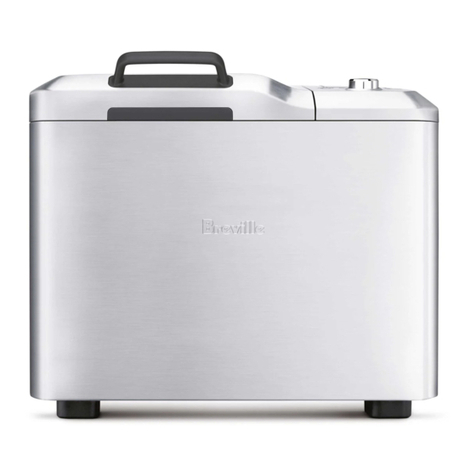
Breville
Breville the Custom Loaf BBM800 Instruction book
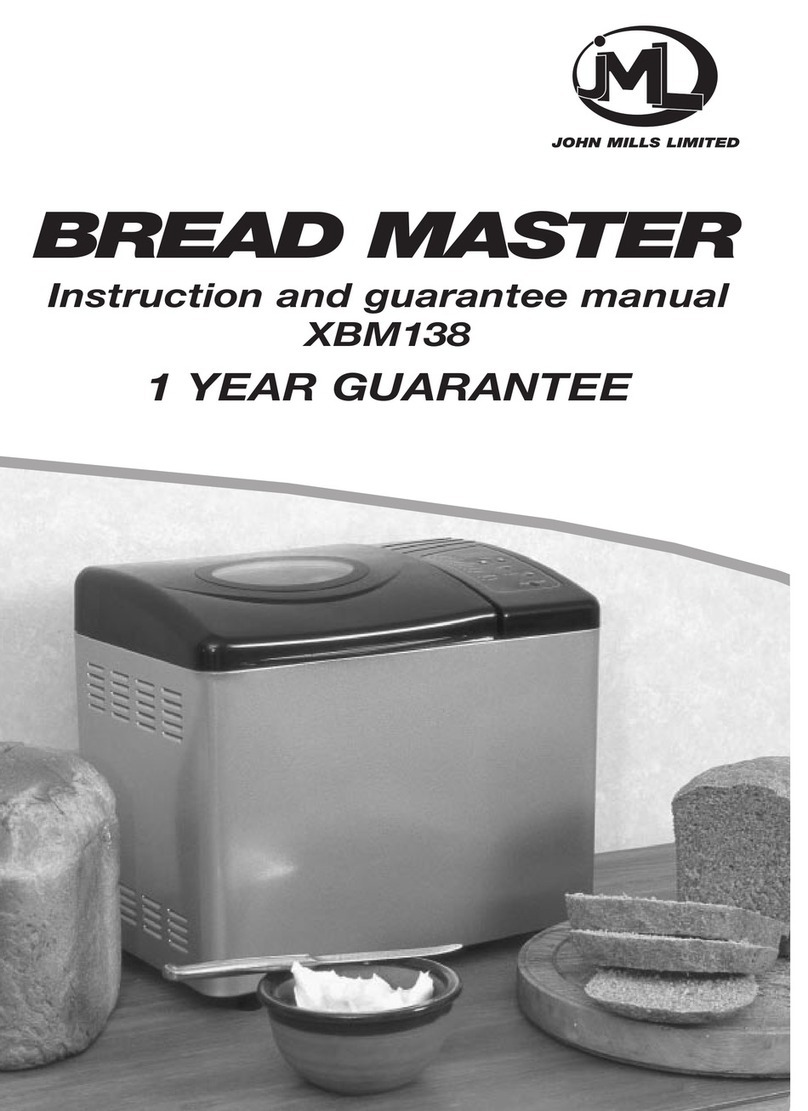
John Mills
John Mills BREAD MASTER Instruction and guarantee manual
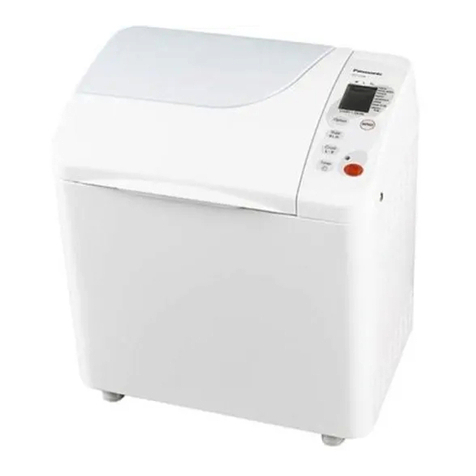
Panasonic
Panasonic Bread Bakery SD-253 Operating instructions & recipes

Panasonic
Panasonic SD-257 Operating instructions and recipes

eta
eta Harmony II user manual
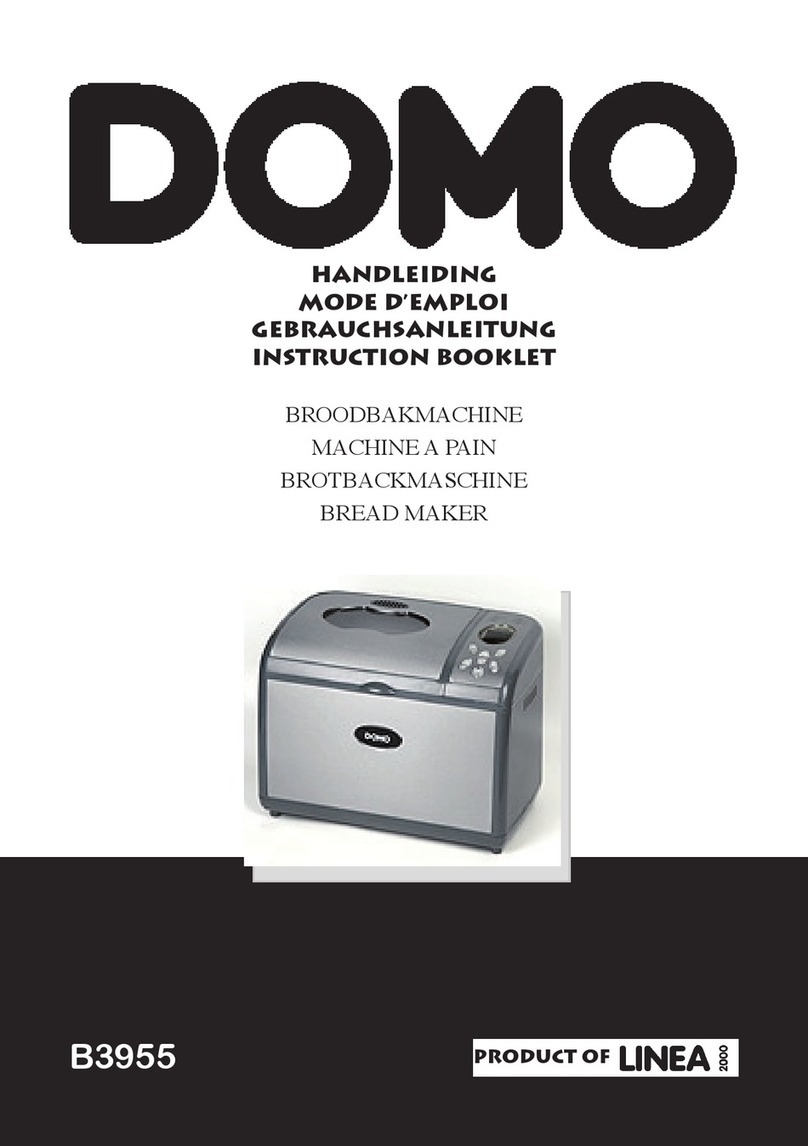
Linea 2000
Linea 2000 DOMO B3955 Instruction booklet
